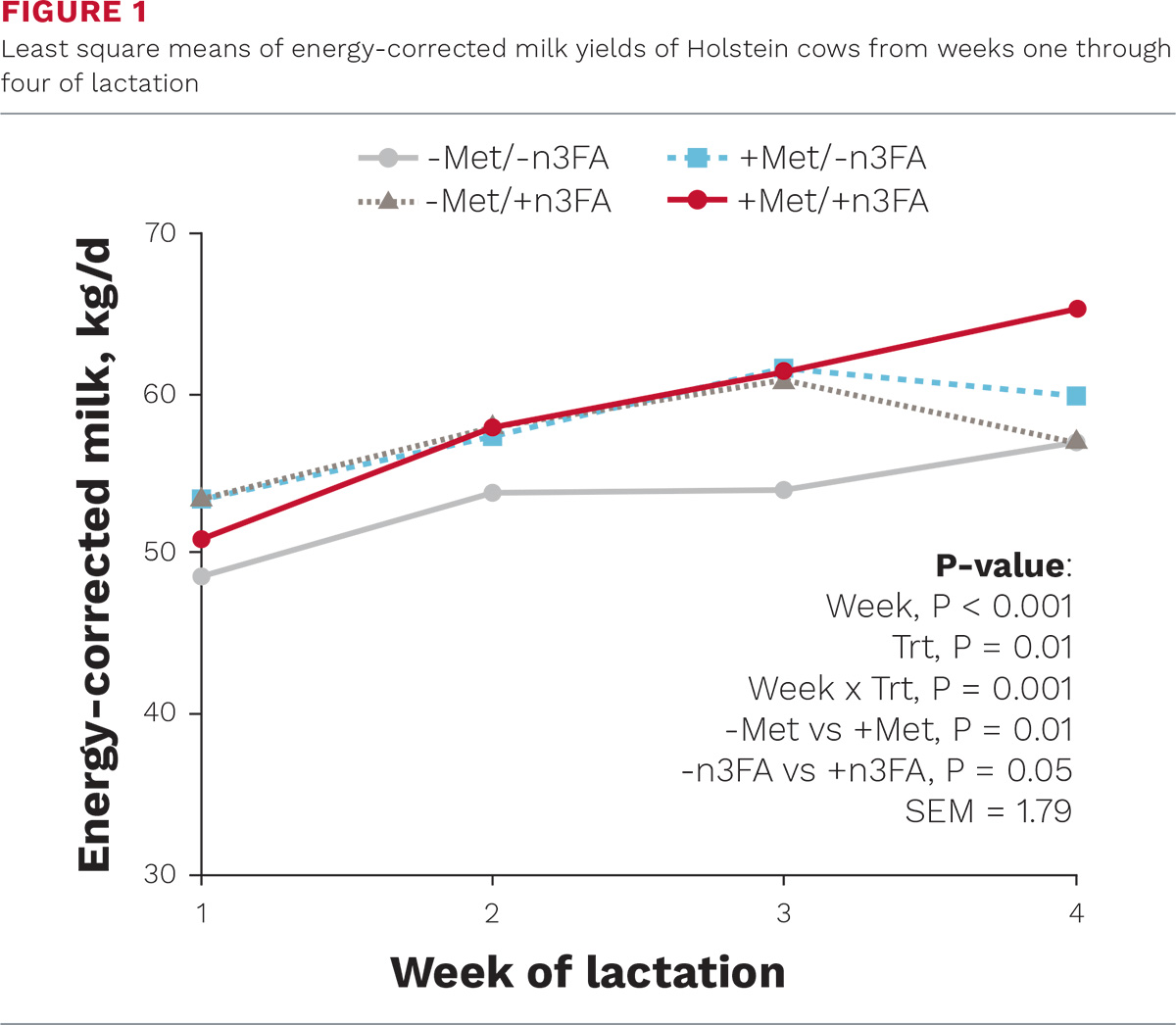The transition period, characterized as the three weeks pre- through three weeks postpartum, is a critical life event for the dairy cow. Around calving, cows involuntarily reduce feed intake; however nutrient demands increase to support fetal growth and milk production. A systemic inflammatory response also occurs at calving which can increase the risk for developing metabolic diseases. For example, the development of fatty liver is a common condition for the transition cow. Milk loss from health incidences particularly in the first 21 days in milk are major contributing factors for economic loss in the dairy industry. Because of these challenges, nutritional strategies are implemented with the goals of improving health and milk production in the transition cow. Methionine (Met) and omega-3 fatty acid (n3 FA) feeding have received attention due to their health benefits.
Methionine is an essential amino acid and the first limiting amino acid for milk synthesis in cows. The industry utilizes rumen-protection (RP) technologies to enhance post-ruminal supply of Met to the cow. Enhanced Met status improves milk and milk protein synthesis, reduces oxidative stress, and enhances liver function in cows. Past recommendations for feeding Met have been to feed RP-Met at 0.08 percent of ration DM. However, considerable progress at Cornell University has been made to formulate diets based on individual amino acid requirements in lactating cattle on the basis of metabolizable energy supply.
Fatty acids (FA) are fed to dairy cows to increase energy density of the diet. Omega-3 fatty acids are fed to cattle as calcium salts to protect against ruminal degradation and increase post-ruminal delivery for intestinal absorption. Eicosapentaenoic acid (EPA; C20:5) and docosahexaenoic acid (DHA; C22:6) are two very long chain n3 FAs commonly found in fish oil. EPA and DHA can activate the anti-inflammatory response as they are precursors to resolvins and protectins, two important inflammation-resolving mediators. EPA and DHA can simultaneously reduce the inflammatory response by inhibiting proinflammatory cytokines. There are, however, no established feeding rates for n3 FAs in dairy cattle.
But… what is the connection between Met and n3 FAs? Met is considered a methyl donor and is a precursor to the universal methyl donor S-adenosylmethionine (commonly known as SAM) which donates methyl groups via the phosphatidylethanolamine-N-methyltransferase (PEMT) pathway to form phosphatidylcholine (PC). There is evidence in non-ruminants that the PEMT pathway prefers very long chain FA such as DHA. The production of PC is critical for the formation of very-low-density lipoproteins which aid in reducing fatty liver while partitioning fats to the mammary gland to incorporate into milk. We believe that this pathway is downregulated during the transition period due to insufficient dietary supply of Met and n3 FAs. Because little is known about the effects of co-supplementation of these nutrients, we conducted a study to investigate the effects of dietary Met and calcium salts enriched in n3 FAs on milk production and liver function in transition cows.
In a randomized study design at Cornell University, 79 multiparous Holstein cows were assigned to one of four dietary treatments:
- Met unsupplemented (-Met) with calcium salts of palm oil not enriched in n3FA (-n3FA; 0 percent n3FA; EnerGII; Virtus Nutrition, USA)
- Met supplemented (+Met; Smartamine M; Adisseo Inc., France) with -n3FA
- -Met with calcium salts enriched in n3FA (+n3FA; 3.2 percent EPA and DHA; EnerG-3; Virtus Nutrition, USA)
- +Met with +n3FA from week -three prior to expected calving through week four of lactation
Cows were fed corn silage-based TMR, both pre- and postpartum, which were formulated to provide Met at ≤ 0.96 or ≥ 1.13 g Met / Mcal metabolizable energy for -Met and +Met, respectively. Calcium salts were fed at 1.5 percent FA (percent of ration DM) for all treatments. Liver biopsies were performed at -1, +1, and +3 weeks relative to parturition. Blood samples were collected weekly. Cows were milked thrice daily and milk samples were collected twice a week.
We first discovered that postpartum dry matter intake increased in both +Met and +n3FA diets compared to -Met/-n3FA. And while milk yields were not different between treatments, we found that energy-corrected milk yields were greater in +Met and +n3FA diets compared to -Met and -n3FA (Figure 1).

Interestingly, energy-corrected milk yields had an overall increase of 5.53 kg/d in the co-supplementation (+Met/+n3FA) diet compared to -Met/-n3FA.
To understand the effects of co-supplementation on liver function and to provide a potential explanation as to why we observed greater energy-corrected milk yield in +Met/+n3FA, we first calculated liver functionality index values. This calculation utilizes concentrations of serum bilirubin, albumin, and total cholesterol, all of which are considered negative acute-phase proteins (APP) found in the liver. Negative APP concentrations will change relative to the onset and recovery of an inflammation occurrence. A higher liver functionality index value is indicative of a greater-functioning liver and the cow’s ability to recover from inflammation (in this case due to the calving process). We found that the postpartum liver functionality index values tended to be greater in cows fed +Met/+n3FA diet (Figure 2).

We wanted to determine if methyl donor metabolism is altered in the liver to further our idea that the co-supplementation feeding strategy would improve liver function. To do this, we measured liver SAM and S-adenosylhomocysteine (SAH) concentrations. SAM is converted to SAH via the PEMT pathway, such that measuring these metabolites can be used to indirectly determine the activity of the PEMT pathway. While SAM was not affected by treatment, liver SAH increased with +Met or +n3 FA’s, indicative that both Met and n3 FA upregulate the PEMT pathway in transition cows.
Our study shows that feeding transition cows a diet adequate in Met and with calcium salts enriched in n3 FAs can enhance lactation performance by increasing energy-corrected milk yield over the first four weeks of lactation and improve liver function by altering liver methyl donor metabolism.
 |
This article appeared in PRO-DAIRY's The Manager in November 2022. To learn more about Cornell CALS PRO-DAIRY, visit PRO-DAIRY. |










